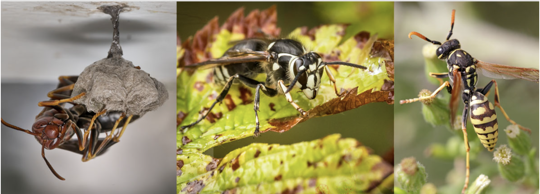Wasp vs. Yellow Jacket vs. Hornet in Snohomish County: What’s the Difference—and Which One’s the Real Threat?
As summer settles into Snohomish County, stinging insects are on the rise. Wasps, yellow jackets, and hornets may seem interchangeable at first glance, but they differ in behavior, nesting habits, and the risks they pose to people, pets, and property.
Understanding how to tell them apart is the first step in staying safe—and knowing when to call in the pros.
Why Are Wasps, Yellow Jackets, and Hornets a Problem in Snohomish County?
The warm, dry weather and abundance of food in late spring and summer create perfect breeding conditions for stinging insects. These pests often build nests under eaves, in gardens, patios, and even inside wall voids—leading to surprise encounters and serious safety concerns.
Here’s a closer look at the most common culprits:
Paper Wasps
Slender and reddish-brown or black with long legs, paper wasps build umbrella-shaped nests under eaves, porch railings, and overhangs. They’re generally non-aggressive but will sting if their nest is threatened.
Yellow Jackets
Often mistaken for oversized wasps, hornets (like the bald-faced hornet, which is technically a type of yellow jacket) are larger, louder, and very territorial. They build enclosed, football-shaped paper nests in trees, bushes, or high on structures and don’t hesitate to defend their turf.
Hornets
Stocky, fast-moving, and highly aggressive, yellow jackets have bright yellow and black stripes and are responsible for most stings reported in Snohomish County. They nest underground, in wall voids, or inside hidden cavities—and can sting multiple times.
Whether you’re seeing wasps in Everett, yellow jackets in Snohomish, or hornets in Lake Stevens—early action is key to prevention.
Early Warning Signs of a Nesting Problem
Spotting signs of infestation early can prevent painful stings, property damage, and nest expansion. Watch for:
Consistent buzzing near siding, soffits, or vents
Repeated insect traffic in one area can indicate a nearby nest.Visible nests
Look for open, papery nests (paper wasps), enclosed gray ones (hornets), or no visible nest but heavy activity (yellow jackets nesting underground or in walls).Aggressive behavior
Swarming, dive-bombing, or unprovoked stings could signal a mature colony nearby.Insect activity around food and trash
Yellow jackets especially are drawn to sugary drinks, meats, and open garbage—especially in late summer.
How to Prevent a Stinging Insect Infestation
A few smart habits can make your home less attractive to wasps and yellow jackets:
Seal gaps around eaves, siding, and vents
Inspect your home’s exterior regularly and seal small entry points with caulk or screening.Keep outdoor trash tightly sealed
Empty bins often and clean up food scraps and drink spills.Avoid leaving pet food or sugary drinks outside
Trim overgrown shrubs and trees
This removes potential nesting spots and limits access to upper parts of your home.
Live in Monroe, Mukilteo, or Mill Creek? Routine maintenance can go a long way in keeping your home sting-free.
Why Professional Treatment Is Safer (and Smarter)
DIY nest removal is risky. Disturbing a mature yellow jacket or hornet nest—even accidentally—can trigger aggressive defense behavior, leading to multiple painful stings or even allergic reactions.
At Snohomish Pest Control, our trained technicians specialize in safe, effective stinging insect removal:
Correct species ID (so you know what you’re dealing with)
Thorough inspections of yards, eaves, and structures
Targeted treatment with professional-grade products
Guaranteed service and prevention tips for long-term relief
From yellow jackets in crawlspaces to hornets in the hedges, we’ve got your back.
Frequently Asked Questions (FAQs)
Q: What’s the main difference between wasps, yellow jackets, and hornets?
A: Wasps are slender and build open nests, yellow jackets are aggressive and nest underground or in walls, and hornets are larger and more territorial with papery nests.
Q: Which stinging insect is the most aggressive?
A: Yellow jackets are generally the most aggressive, especially in late summer. They can sting multiple times and are easily provoked.
Q: Can these insects sting more than once?
A: Yes—unlike bees, wasps, yellow jackets, and hornets can sting repeatedly.
Q: Are stinging insects dangerous for pets?
A: Absolutely. Pets may disturb a nest accidentally and suffer multiple stings, especially around the face or paws.
Q: Is it safe to remove a nest myself?
A: DIY removal is risky. These insects defend their nests aggressively. Professional removal ensures safety and long-term prevention.
Final Thoughts
Knowing the difference between wasps, hornets, and yellow jackets can help you make smart decisions—and avoid unnecessary risks. If you notice increased buzzing, visible nests, or aggressive swarming, it’s time to call in the experts.
📞 Need help identifying or removing a nest? Contact Snohomish Pest Control at 425‑600‑7755 or visit www.snohomishpest.com to schedule your service today.

